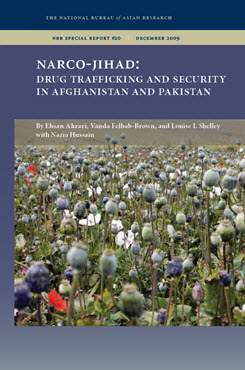The Drug Economy in Afghanistan and Pakistan, and Military Conflict in the Region
This essay assesses the nexus between the narcotics economy and violent conflict in Afghanistan and Pakistan.
EXECUTIVE SUMMARY
This essay assesses the nexus between the narcotics economy and violent conflict in Afghanistan and Pakistan.
MAIN FINDINGS
- While opium production in Afghanistan declined in 2008–09, it was significantly higher than the estimated total global demand for illicit opiates. Overproduction, not counternarcotics efforts, primarily accounts for the reductions in cultivation and production over the past two years.
- Price profitability of opium poppy is not always the most important structural factor driving the narcotics economy in Afghanistan. Insecurity and the lack of infrastructure, value-added chains, assured markets, legal microcredit, land titles, access to land rent, dispute resolution mechanisms, and the rule of law are frequently more important factors than price profitability.
- Currently a multitude of actors are involved in Afghanistan’s opium poppy production, including the Taliban, all levels of the Afghan government, law enforcement, unofficial powerbrokers, and tribal elites.
- Without a legal alternative economy in place, poppy bans and eradication campaigns have proven economically devastating for the population, socially and politically unsustainable, and counterproductive for the counterinsurgency effort.
- Without a reduction in the global demand for illicit opiates, a significant reduction in the opium poppy economy in Afghanistan will shift production elsewhere, including possibly to Burma, Central Asia, or Pakistan.
POLICY IMPLICATIONS
- An alternative legal economy cannot consist of a monocropping system, such as with wheat. For legal livelihoods to be sustainable and effective in Afghanistan, they need to consist of high-value, labor-intensive, diversified crops, such as fruits and vegetables.
- The longer alternative livelihood programs fail to provide economically sufficient replacements for opium poppies, the more problematic it becomes for local elites to endorse eradication and the more the local communities become susceptible to mobilization by the Taliban.
- A shift of the opium poppy economy to Pakistan would be highly detrimental to U.S. interests, further destabilizing the Pakistani government, threatening the government’s territorial control and integrity, and fueling militancy by providing Pakistani jihadists and possibly also Baluchi insurgents with significant financial profits and extensive political capital that is currently not available to these groups.


